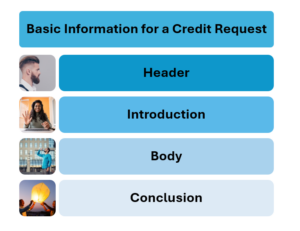Creating Credit Requests – Basic Format & Specific Guides
There are many different ways to draft a credit request. Most student create written requests, but it’s o.k. to do a website or a graphic or whatever makes sense given the field in which you want to request credit.
The key pieces you want to ensure you have in a credit request are:
- clear identification of your overall topic of knowledge
- clear sub-topics of knowledge that you have learned within the overall topic
- detailed discussion and explanation of each sub-topic of knowledge
Use a Basic Information Format
No matter how you draft your request, there are basic pieces of information that need to be included so that your learning can be evaluated.

Explanation of Basic Information
Header
- your name
- topic of knowledge of the credit request
- number of credits requested
- credit level
Introduction
The introduction is like a snapshot in the first paragraph; include information that can help a faculty evaluator understand the situation in which you gained your learning.
- who you are
- what your experiential learning is
- how you gained your knowledge: from direct experience, training, self-initiated reading, or some or all of the above, for how many years, where, etc.
Finish with a direct statement of the request, such as “Based on the above, I am requesting [X] number of credits in [insert your overall topic of knowledge here].”
Body
Break down your overall topic of knowledge into sub-topics of knowledge.
The body should use sub-headings which identify the sub-topics of knowledge you have gained in this overall topic. Add examples and details under those sub-headings that explain each sub-topic more fully.
Public Speaking example of sub-topics of knowledge:
- public speaking vs. interpersonal communication
- types of speeches
- audience analysis
- use of visual aids
- audience participation
Conclusion
A conclusion reiterates the request. Whether an essay format or other format, the introduction, body, and conclusion structure helps you create a logical flow of information.
Additional Information for the Body of a Credit Request – add more categories as appropriate

Consult Appropriate CPL Guides
Empire has a number of CPL guides which ask leading questions for you to consider as a way to help you identify your learning, explain how you have applied that learning, and draft a credit request.
There is a general guide using the basic format shown above, and one that uses questions from the Global Learning Qualifications Framework.
There are many guides in specific subject areas that students often pursue through credit for prior learning, e.g., supervision, administrative services, human services delivery, management, business communication, project management, and more.
Link to Empire’s Credit for Prior Learning Library Guide to see the array of guides available.
Consult Sample Credit Requests
The Empire Credit for Prior Learning Library Guide also has a number of sample credit requests. Read some of the samples and identify characteristics that you would like to incorporate into your own credit request – what resonates with you in terms of how the information was presented, what headings and sub-headings were used, and how was information organized overall? [again, make a link when we have the libguide]
Consult AI
Ask AI to identify the content that’s usually included in a college course in X [your overall topic of knowledge].
Remember that you don’t have to match all of the usual content that AI lists. Instead, use AI for some ideas about naming and organizing your sub-topics of knowledge.
Consult the table of contents in a textbook
This is the same as doing research using AI – it’s the low-tech version. Again, know that you don’t have to exactly match textbook contents.
Remember that YOU are your own best resource
Whether using a guide or your brainstorming or mind-mapping results, remember that you are the expert on your learning. Don’t try to fit information into a credit request just because there’s a question in a guide to answer, or because AI or a textbook lists a certain sub-topic of knowledge. You need to be comfortable with and confident in the information you present in a credit request.
